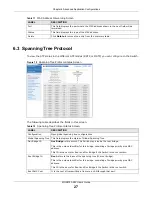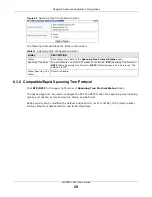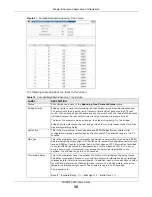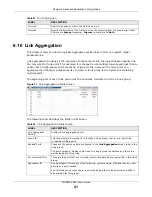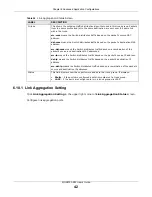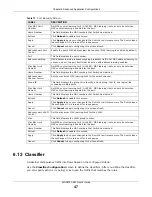
Chapter 6 Advanced Application Configurations
MGS3750-28F User’s Guide
33
6.4 ERPS Protocol
ITU-T G.8032 Ethernet Ring Protection Switching (ERPS) provides protection and prevents loops for
Ethernet traffic in a ring topology.
Figure 23
ERPS Screen
The following table describes the fields in this screen.
Priority
Configure the priority for each port here.
Priority decides which port should be disabled when more than one port forms a loop
in a switch. Ports with a higher priority numeric value are disabled first. The allowed
range is between 0 and 255 and the default value is 128.
Path Cost
Path cost is the cost of transmitting a frame on to a LAN through that port. It is
recommended to assign this value according to the speed of the bridge. The slower
the media, the higher the cost.
Table 15
Multiple Spanning Tree Protocol Screen
LABEL
DESCRIPTION
Table 16
ERPS Screen
LABEL
DESCRIPTION
Global ERPS Status
Enable/disable ERPS function for the entire zone.
Instance
Instance range is from 0-15; it works in a way similar to domains in ERRP.
Search
Click
Search
to find instances.
Meg Level
Used with CFM and is consistent with CFM level. CFM is mainly used for faults other
than linkdown such as one-way connections; ERPS will work normally if CFM is
disabled, but will not be able to detect one-way connection faults.
Ring ID
Ring ID range is 1-239. Ring IDs can be duplicated, but the Control VLAN must be
different, and vice versa.
Ring Level
In an ERPS network, there must be at least one major ring, but there can be multiple
sub-rings. ERPS protocol packets for sub-rings will be passed to the major ring, but
not between major rings.
Control VLAN
The Control VLAN range is from 2-4094. The destination VLAN in the ERPS protocol
packet must be a VLAN that does not exist on the system.
Protected-instance
List
Enter the protection instance information in this field. The same port can not be
configured with the same protection instance in different ERPS.









